Marketing has evolved since the dawn of the Internet in the 80’s with multiple mediums and channels to promote a brand.
Before this, reaching your target audience means shooting in the dark through outbound marketing channels like broadcast media, and print media. It had limited ways to personalize the audience experience.
The Internet opened the floodgate to websites, followed by emails and social media enabling two-way communication.
As a result, here’s what happened:
The past few decades saw a rise of marketing channels and touchpoints that simplified the way we engage our target audience and guide them through the funnel.
Now, the biggest question is: What channels to use?
Scroll down to learn what’s trending, bringing the highest turnover.
Table of Contents
Digital Marketing Trends - Types and Channels
Digital marketing channels have come a long way from simply conveying brand messages through ads.
These are some of the practices in trend over the past few years.
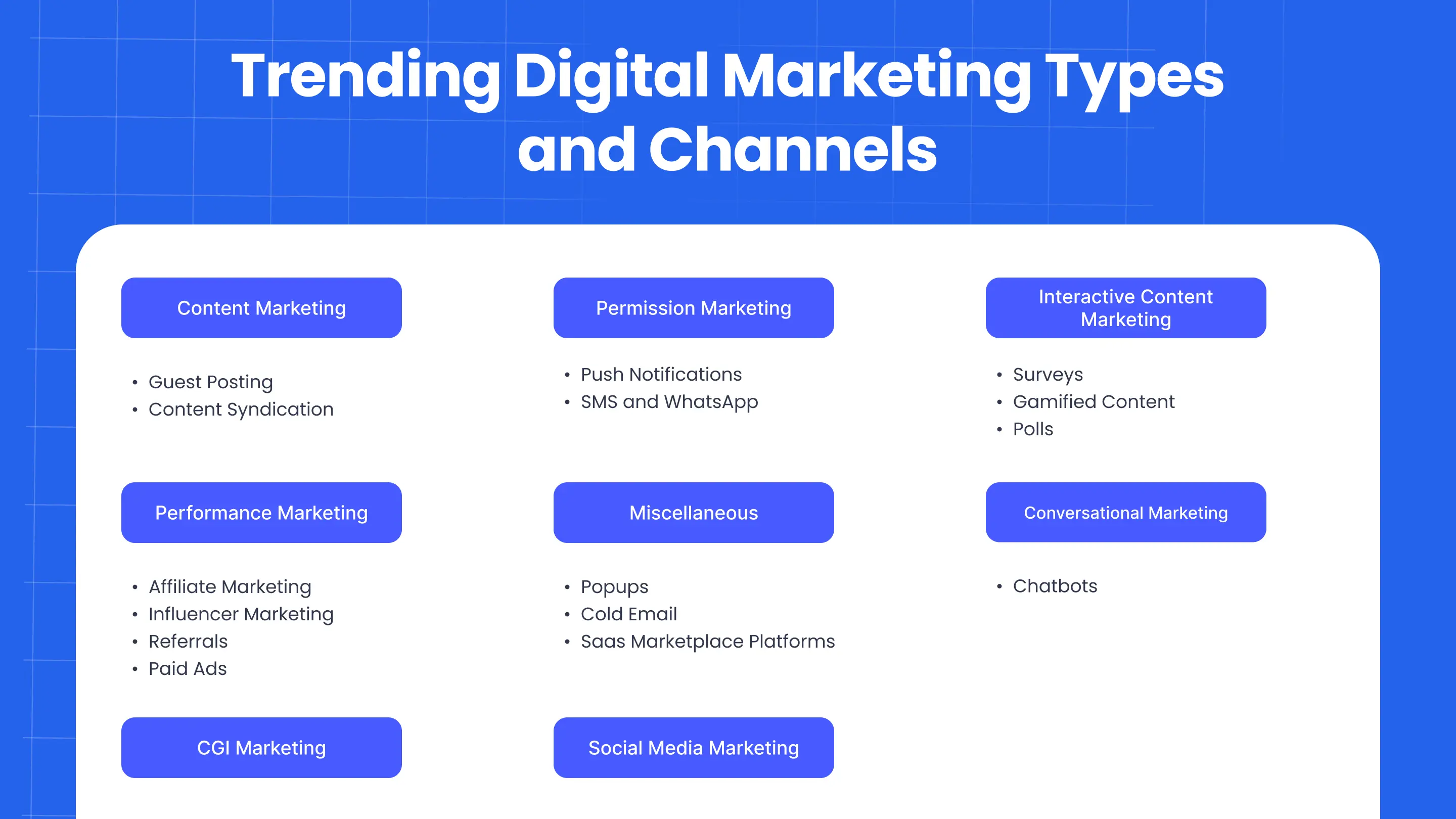
These changes are further catalyzed by the booming AI industry, rethinking how we solve customers’ problems and shape buyer behavior. One significant advancement is the applications of diffusion models for AI, which are transforming various aspects of digital marketing through enhanced predictive capabilities and image generation.
We found the following channels effective and widely used through the growing complex online marketing sphere.
CGI Marketing
CGI marketing is an emerging trend nowadays leveraged by many top brands like Coca‑Cola, Adidas, Stuart Weitzman, Skybags, L’Oréal, and Haldiram’s for their advertising purposes.
CGI Marketing uses computer-generated visuals in addition to traditionally shot videos and images. It enhances the visual appeal using hyper-realistic and mind-bending images that make your content more memorable.
You can show renderings of complex products, highlighting features that a buyer shouldn’t miss.
Go beyond generic infographics and explainer videos for your B2B products by making them visually engaging.
E-commerce businesses can offer virtual try-ons, showrooms, and product configurations giving them a good idea about the product, its use, and how they can customize it as desired.
Benefits: CGI marketing campaigns tend to go viral when done right. A way to increase brand awareness, engagement, and customer loyalty, so long as you send a powerful message.
With CGI, you have a headstart in promoting your products before they are created.
You have more room for creativity and captivate your audience with stunning visuals.
By connecting with your audience on an emotional level, you can make them come back for more.
Challenges: Creating high-quality CGI can be expensive. This can be a barrier for businesses with budget constraints. It requires a skilled team which can add to the cost and complexity.
Interactive Content Marketing Channels
Interactive marketing uses engaging tools to communicate with the audience in a way that makes them active participants, far from how the traditional way of marketing worked.
Using interactive videos, images, gamified content, surveys, polls, quizzes, and personalized content can get them involved.
Let’s discover some types that help engage and understand your customers.
Among the many interactive content marketing channels, QR codes are growing in popularity for their ability to engage users instantly with a scan. Consider using a user-friendly QR code generator to create custom, branded QR codes that catch attention and drive interaction, enabling seamless access to content or promotions.
Surveys
Surveys are the ideal solution for collecting customer feedback, and insights, performing marketing research, and measuring customer satisfaction.
Benefits: You can reach a wider audience with a simple online tool that brings you the information you need. It is the most cost-effective method out there to conduct market research.
Surveys are convenient for users and therefore have a higher response rate than any other channel. Anonymity makes it easier to gather honest opinions or feedback.
You can personalize your questions in a way that you condition the flow of your questions according to audience response using AI-powered tools like GoZen Forms. This way, you collect quality responses that are coherent and provide you with insights.
Challenges: The relieving point about surveys is that you can distribute them anywhere using emails, push notifications, website popups, and almost half the channels mentioned here.
However, it can be difficult to get people’s attention and engage them unless the surveys are simple to use and attractive. Take a look at our survey templates. They are not easy to avoid.
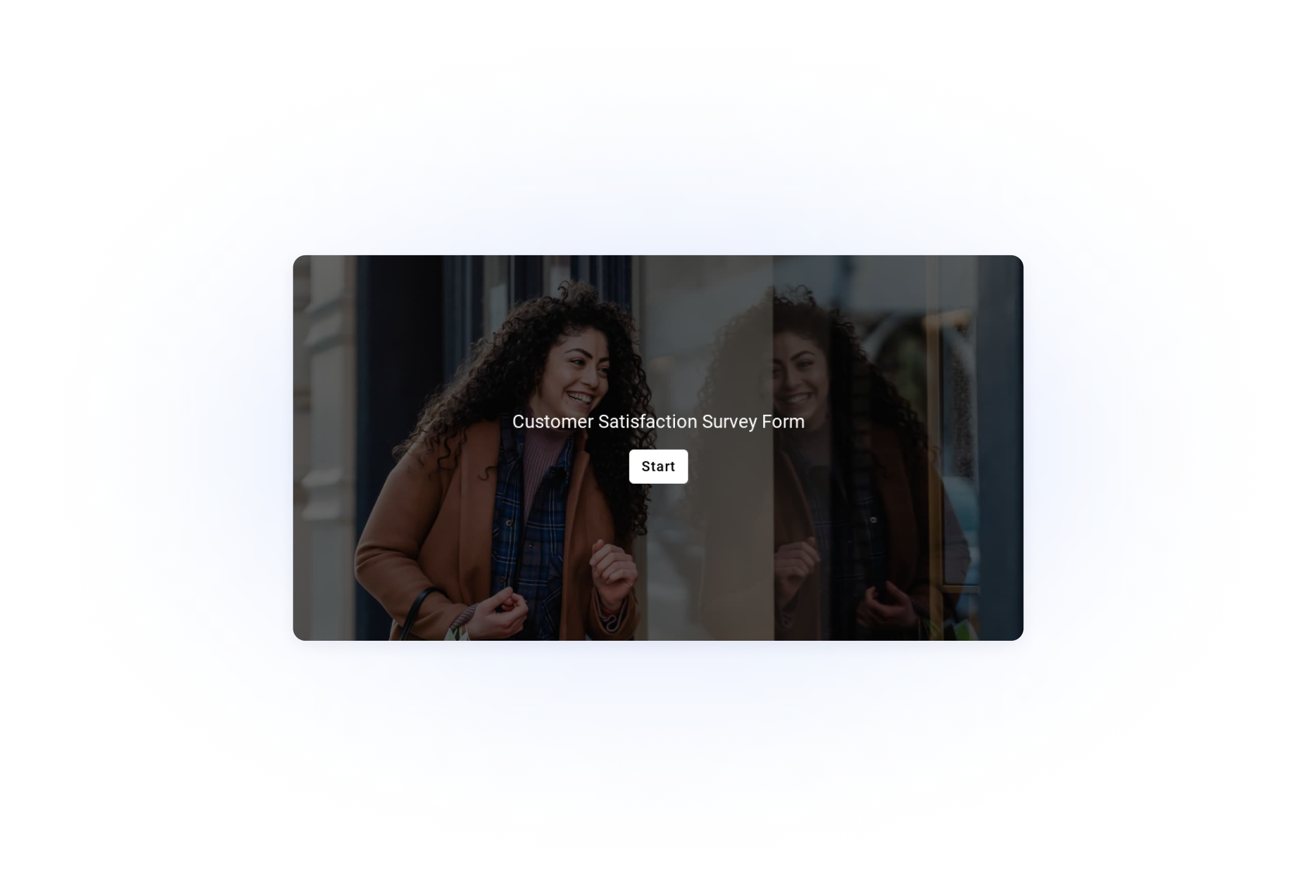
Gamified Content
Gamification is a strategy that incorporates game-like elements into marketing campaigns engaging users and helping you grow your audience.
Including elements like progress bars, rewards, points, leaderboards, and games in your content marketing strategy can attract the user and compel them to engage.
They can be added to your websites, shared on socials, and used on apps.
Benefits: Gamified content taps into user motivation to get them to engage as people love a good challenge. It can help boost your brand awareness and build an audience base.
If you’ve nailed this, engaged users get your content to spread widely, increasing social sharing by 22%.
Following this can further encourage users to take action, sign up, or buy a product. Doing this creates a good experience for customers who can be retained for long.
Challenges: Poor implementation can deter you from achieving your goals.
Polls
Polls are your go-to marketing tool to learn about your audience’s opinions, preferences, and needs. They give you the qualitative data you need to gauge your marketing or business performance other than just using metrics.
They can be posted on social media, embedded on landing pages, and blog posts, included in emails, SMS, and distributed as QR codes.
Benefits: Polls are inherently engaging because they do not have as many questions as surveys do.
Some types of polls show you what your audience prefers the most as a group. Drawing insights using polls is easier if your question is on point. You can also assess the general sentiment towards your brand.
Challenges: Polls have a low response rate unless your question is interesting and valuable.
Asking the right question is key to effectively using polls.
Performance Marketing Channels
Performance marketing is a result-driven strategy where you pay for the goals achieved.
It focuses on conversions, including certain actions that users take, such as signing up for an email list, completing a purchase, driving engagement, and more.
This is far from how traditional advertising performs, where you pay upfront and hope to hit the mark.
Performance Marketing makes your strategy more targeted and cost-effective.
Below are some types of Performance-based Marketing: Paid Ads, Influencer Marketing, Affiliate Marketing, and Referrals.
Paid Ads
There is no doubt that Paid Ads are still a go-to medium for ecommerce brands. I have seen so many cosmetics brands in our locale scale their business to millions using Paid Ads lately.
Paid Ads are a marketing model where you pay to promote your offers through platforms like Google Ads or Meta Ads.
It works on an auction system, pushing advertisers to bid on their display time. Platforms that run the ads also consider content quality and engagement rate in addition to the bid rate.
Pay-per-click (PPC) advertising is a kind of paid ad that only pays to every click.
Benefits: Paid ads can be fast in bringing traffic or followings by targeting a highly specific target audience. This is especially beneficial when launching a product or time-sensitive promotions.
More people will come across your brand. When done right, paid ads can increase leads generated and sales.
Challenges: It is competitive to get your ads in a slot. This can lead to making higher expenses.
Your ad copy must be compelling and creative to appeal to your target audience.
Strategies like email marketing, social media content creation, and SEO are some effective alternatives to grow organically.
Influencer Marketing
When social media gave birth to content creators for specific niches who had a loyal following and built a community, businesses leveraged them to promote their products.
As social beings, we do what our community does. Moreover, influencers who have built trust with their community are seen as reliable sources of information.
They spin compelling narratives around the benefits of a product and create social proof out in the open.
Therefore, we buy it.
Benefits: Three reasons why influencer marketing is highly beneficial when compared to traditional advertising:
Challenges:
While B2B influencer marketing is still in its inception, this strategy is working wonders for many B2C businesses.
Affiliate Marketing
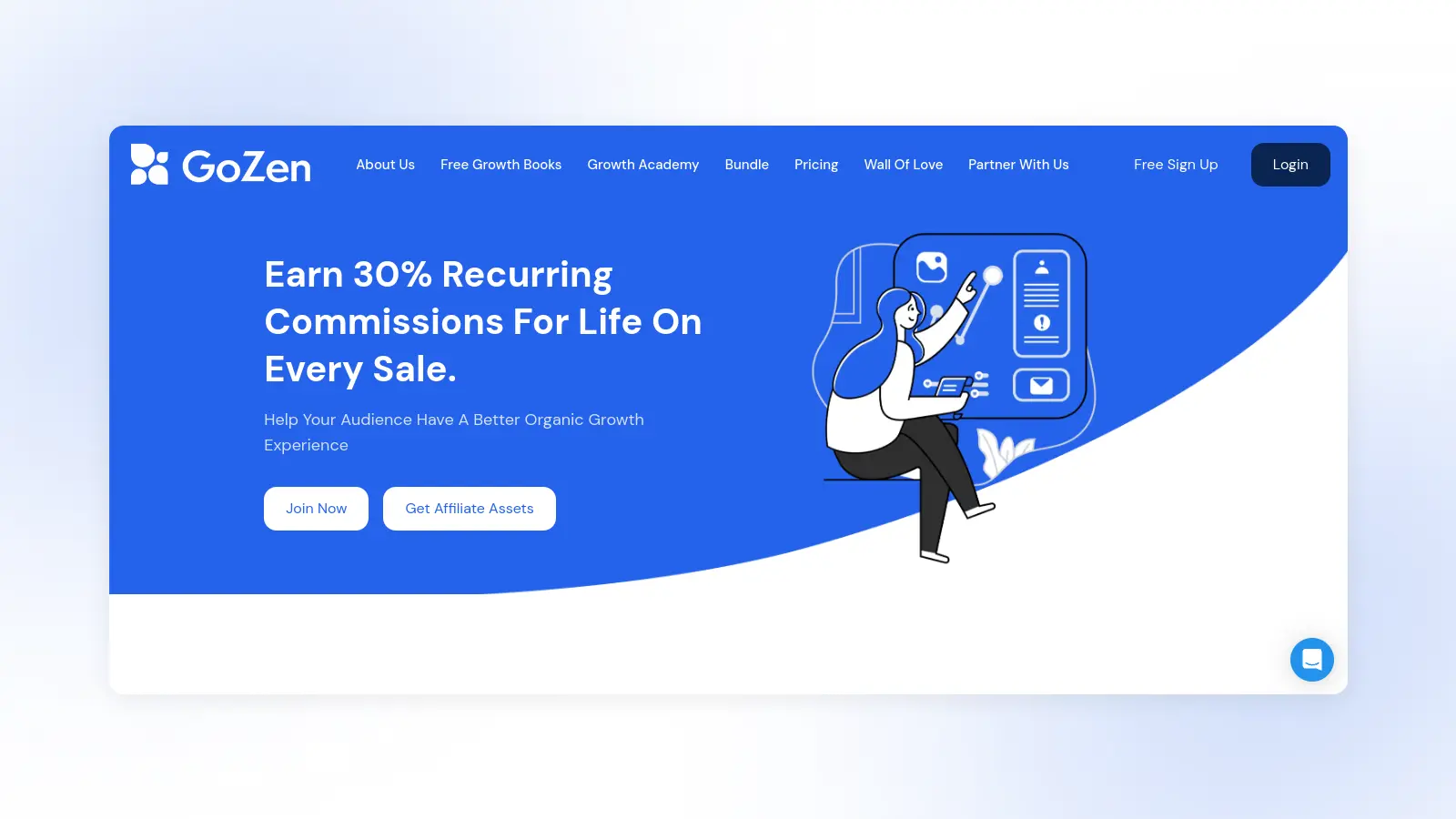
Affiliate Marketing is a strategy where you promote a company’s product or service in exchange for a commission.
It follows a cost-per-action model where you are commissioned for every conversion move.
Companies with affiliate programs provide you the marketing goals along with unique affiliate links that track every sale made from your efforts.
Affiliates promote the product on various channels like blogs, social media, communities, and email. 59% of affiliates partner with influencers to achieve their milestone. To better understand this concept, exploring affiliate marketing examples can provide valuable insights into successful strategies.
Benefits: By choosing this over traditional advertising, you’re minimizing upfront costs and only paying for the outcome generated. Like influencer marketing, you can target your audience that aligns with your ICP easily and expand your audience.
Moreover, by inviting backlinks to your website, you’re bringing in organic traffic and have higher chances of ranking in the SERP results.
You can efficiently learn about your customers, the channels they use, potential markets, and audience demographics who’d be interested in what you offer.
Challenges: You may have to be wary of these factors,
However, you can overcome these difficulties with the right strategies.
Referrals
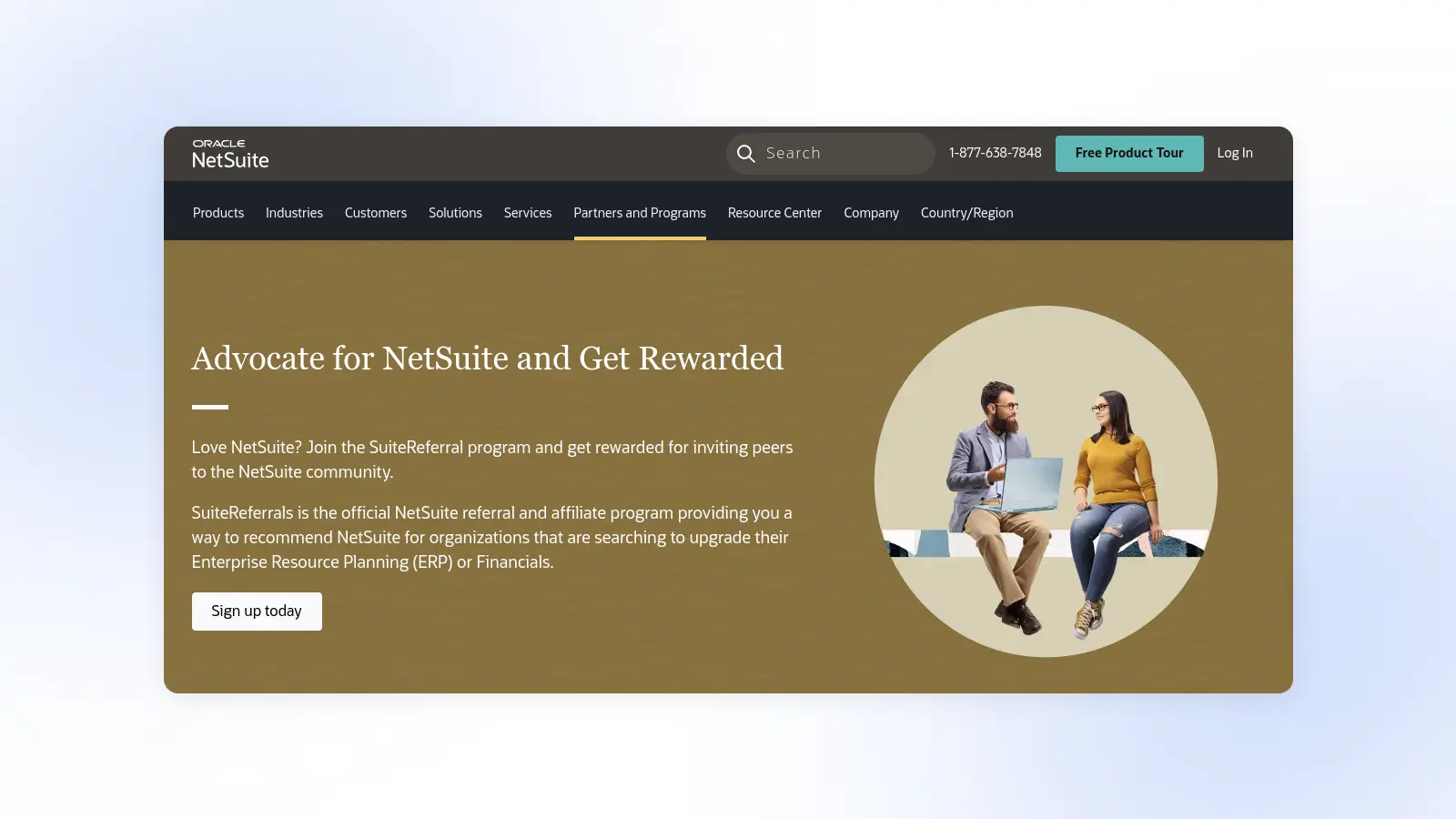
Referrals are recommendations given for a product, service, or business through word-of-mouth, social media, or a referral program. In turn, you pay an incentive to motivate your users and build a long-term relationship with them.
You can also affiliate with referral partners who work on bringing traffic and sales to what you offer.
Best Practice: Lead forms are the most-used referral method according to Truelist, closely followed by emails using which you can notify your customers of your referral programs.
Incentives can be cash rewards, discounts, store credits, product upgrades, and more.
Benefits: Next to social proof, referrals are the most beneficial in convincing people of your product’s worth coming from a trusted customer.
With referrals, you can expect qualified leads who are more likely to convert and build a loyal customer base. You don’t spend much and still spread the word through a satisfied customer.
The best part is they are more likely to stay longer and increase customer lifetime value. Up goes your retention rate.
Challenges: Referral programs take time to bring results. This is because of a need for more engagement and proper promotion.
Many claim that tracking referrals earned can be a problem and has to be managed manually.
Permission Marketing Channels
Targeting the right audience also means ensuring that they want to receive your bidding. Permission-based marketing assures the longevity of your relationship with the audience.
Look into these channels to adopt an opt-in-based marketing strategy, especially if you focus on retention and engagement.
Push Notifications
Push Notifications are time-relevant, personalized, and a smart way to engage your audience with their consent.
You can keep your audience informed or updated even when they are not using the browser or application.
It is primarily seen as a mobile-friendly channel with web-based push notifications widely used in the e-commerce industry.
You can also incorporate deep links to directly take users to relevant content within your mobile app, as well as integrate social proof, such as positive reviews, to boost the credibility and success of your push notifications strategy
Benefits: Push notifications have a 90% retention rate from directly sending timely and personalized messages. This channel has increased engagement, customer satisfaction, and loyalty.
With higher visibility, it surpasses email in its delivery and open rate.
Challenges: Push notifications have a general air of dislike due to their intrusive nature. Overusage and generic, non-targeted messages are unlikely to please your audience.
It may also lead to a cause of distress and sensory overload due to constant pinging.
So, ethical usage without harming user well-being is suggested.
Here’s a simple and effective tool that can carry out all your notifying needs - GoZen Notify.
SMS and WhatsApp
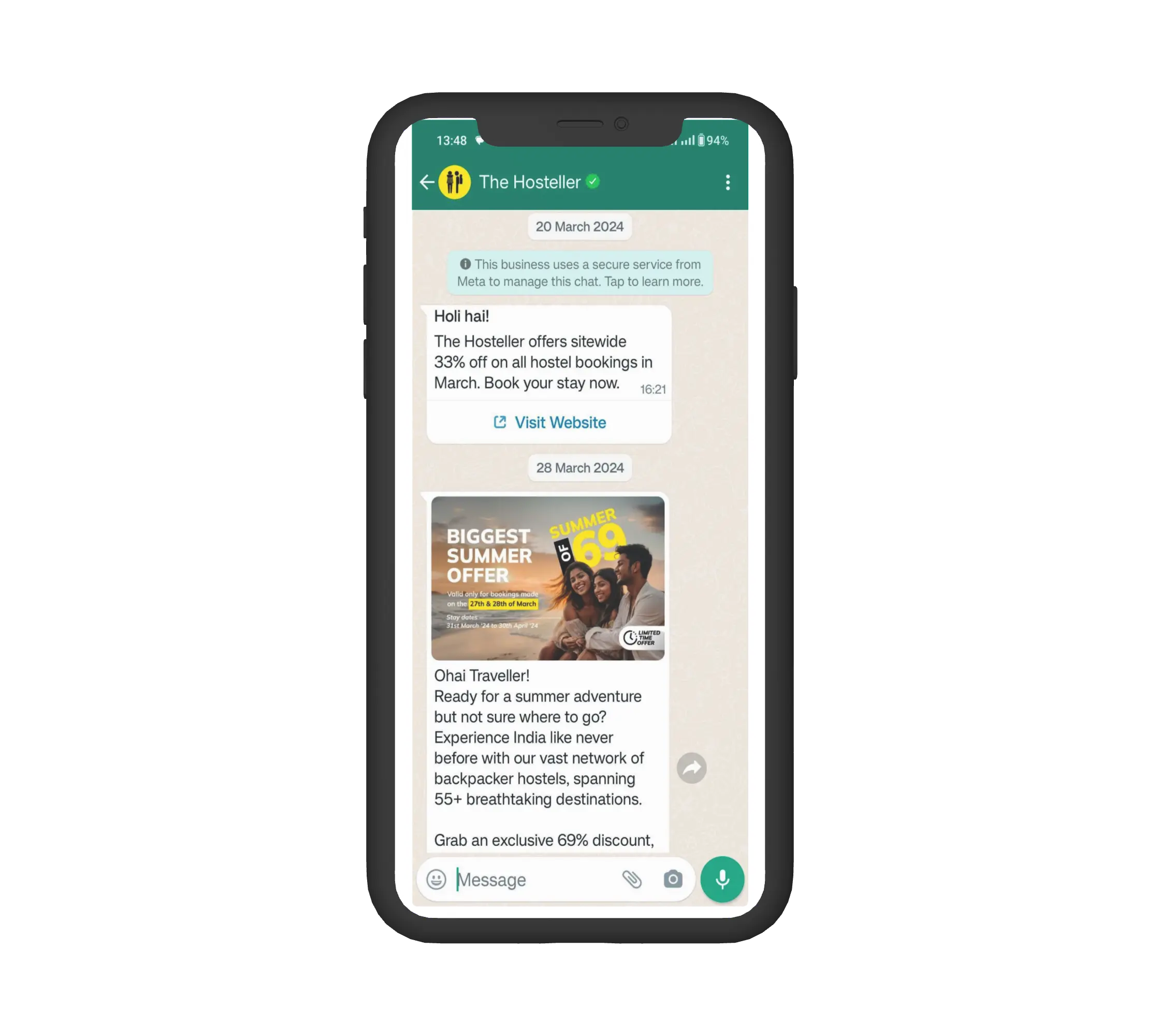
SMS and WhatsApp as marketing mediums enable reaching customers directly when they are constantly using their mobile phones, with various WhatsApp marketing software tools available to help businesses scale their messaging efforts..
SMS has seen conversational AI for SMS to personalize communication, automate responses, and provide a seamless customer experience, ultimately driving engagement. WhatsApp, being the most used messenger app, connects with your target audience and nudges them towards taking immediate action.
Released in late 2021, WhatsApp for marketing has garnered an 83% engagement rate, which is more than popular platforms like Email and SMS.
Mannings E-Commerce saw 8x click-through rates than email and increased their revenue by 40% through WhatsApp Marketing.
Brands can now send customized messages, send product recommendations, and Mannings E-Commerceprovide support throughSMS customer service or proactive interaction using a WhatsApp automation tool with Gen AI being rolled out in WhatsApp, besides the basic automated responses feature for businesses.
You can seamlessly integrate with other marketing channels to kickstart an effective omnichannel strategy with both SMS and WhatsApp.
For B2B, these channels can be used to send reminders of events, offer support, and share educational content. This allows you to build your relationship with customers that may last a long time.
Challenges: Grabbing attention with short messages and encouraging them to click on the links can be challenging.
Targeting and Segmentation are still a hurdle to overcome.
There are always privacy and legal concerns with WhatsApp and SMS marketing. Building trust to get them to opt in takes time and effort.
Social Media Marketing
With the social media landscape shifting constantly to accommodate all kinds of users, it has become easier to promote your brand without costing much.
For a beginning business, your only investment will be on social media management tools, and content creators if budget permits.
Primarily used to build awareness about a company’s product or services, most B2C and D2C businesses are using to create online shops riding the current trending wave.
Social commerce is a great way to provide a seamless shopping experience to your customers.
A brand’s credibility is determined by social proof, like user-generated content created by UGC creators picked up on TikTok and Instagram where users advocate for their products after using it..
A strong social media presence indicates that a B2B brand is a thought leader and aims to build meaningful relationships, and grow a community rather than just sell. Marketers leverage platforms like LinkedIn to find them according to stats.
Benefits: Connecting with the audience in real-time over live chat and interactive content has helped businesses deeply understand and solve their problems. This is made possible through social media marketing.
Challenges: Growing your audience on social media takes time and doesn’t bring quick results.
Keeping up with trends can be difficult and creating relevant content can be even more time-consuming.
However, with consistency, you can build your brand and community.
Content Marketing Channels
Guest Posting
Guest Posting is a content marketing and SEO strategy to attract backlinks to your website and expand your audience.
You write blog articles for other websites within your industry as an expert guest, bringing a fresh perspective and voice to your blog.
Gathering expert opinions enhances the credibility of their site, making this tactic mutually beneficial. You get referral traffic. They get valuable information.
Challenges:

Content Syndication
Syndicating your content like an article, document, or video refers to republishing it on other third-party publishers’ sites and platforms for broader reach.
Blog posts, articles, e-books, infographics, videos, presentations, and research reports are some types of content that can be syndicated.
While it is a cost-effective way to gain traffic, some platforms may charge a fee for better reach.
With content syndication, you have more control over your content than with guest posting.
If you’re B2B focused, you can find relevant platforms where your target audience resides, such as LinkedIn, and industry-related websites. B2C creators post on social media platforms, online communities, and content websites.
You can also use CDP like Outbrain to distribute your content.
Benefits: Reach out to a wider audience and attract traffic to your website. This way you grow your brand.
You can repurpose existing evergreen content making creation easier and appeal to new audiences.
Turn your traffic into leads by collecting their information when they click on the link to your resource.
Challenges: Google may not rank your content if it is duplicated. However, Google recommends using canonical tags pointing to the content you want to be ranked.
The quality of the third-party site can have a good amount of impact on your brand and your site’s reputation. Therefore, ensure that you select the right one.
Conversational Marketing
Conversational marketing strategy engages the audience through two-way communication to understand their specific needs and interests.
Channels coming under this type of marketing help businesses bridge the gap between them and their potential customers, further helping them make a purchase.
Chatbots
Chatbots rely on predefined responses and databases to answer customer/user queries. They are a great way to personalize your customer’s marketing experience.
Offering assistance while searching for your product or service, troubleshooting basic issues, and providing recommendations according to their interest can be immensely helpful to customers who need a quick solution.
Benefits: You can effortlessly collect and qualify leads using the chatbot’s help. Increased one-on-one engagement with users indicates higher chances of conversion.
The best part is making this happen without much human intervention for direct responses which saves everyone plenty of time.
AI-powered chatbots can learn from previous responses and feedback, optimizing your experience more. These are referred to as intelligent chatbots.
Challenges: Only 34% of consumers find this tool helpful in answering their queries, indicating that it will take time for the technology to advance.
It may not be able to answer accurately to nuanced and detailed questions.
Miscellaneous
Cold Email
Cold emailing is an outbound marketing practice that involves reaching out to individuals or businesses who are yet to express interest in your products or services.
You collect a list of leads and send strategically crafted cold emails to them. They aim to initiate a conversation, build relationships, and eventually convert them.
Benefits: Performing targeted outreach means you’re reaching the right people. It allows you to connect directly with them.
It is a cost-effective method that gives you measurable results letting you know the effectiveness of your campaigns.
Challenges: Standing out from the flood of emails can be a hurdle and cold emails are known for their low response rates.
Avoiding spam filters is challenging, especially if you’re using a new domain to send an address.
However, you can increase your chances by using the right cold outreach tools and following the best practices in sending cold emails. Check outGoZen Growth - the only 2-in-1 platform for both cold outreach and email marketing with all the necessary features.
Popups
Traditionally, popups are associated with security threats, as the ads can infect your device with malware. While modern tools have evolved beyond these concerns, it’s still important to understand the risks and adopt effective malware removal practices to ensure your site remains secure and trustworthy for users. Popups are now webpage overlays that appear when a user triggers a specific action within the site.
Revised Text: “AI chatbots use natural language understanding (NLU), a subset of natural language processing (NLP), to interpret user queries and mimic human-like responses. To enhance their performance, developers often utilize prompt templates to structure inputs effectively.
It is supposed to grab the user’s attention and engage them, making them linger on the site before they are encouraged to decide.
While known for being intrusive, popup ads may be less annoying when they communicate relevant content to an interested user. This means they have a high chance of converting into customers or subscribers.
Benefits: You can strategically use them to capture leads using lead magnets like ebooks, whitepapers, and more. Offer promotions to retain your audience, upsell and cross-sell products, and collect feedback using this convenient tool.
Challenges: Unbridled use of it can get you penalized by Google, seriously affecting your SEO.
It may disrupt a user’s experience by blocking their access to the main content. We’ve all grown to ignore them upon reaching a website.
This can impact your engagement rate.
Design is key to guiding your customers with popups. GoZen’s products Engage and Optinly offer interactive and gamified popups that suit your business needs whether you’re in B2B or B2C. A smart way to bring down bounces and boost conversion.
SaaS Marketplace Platforms
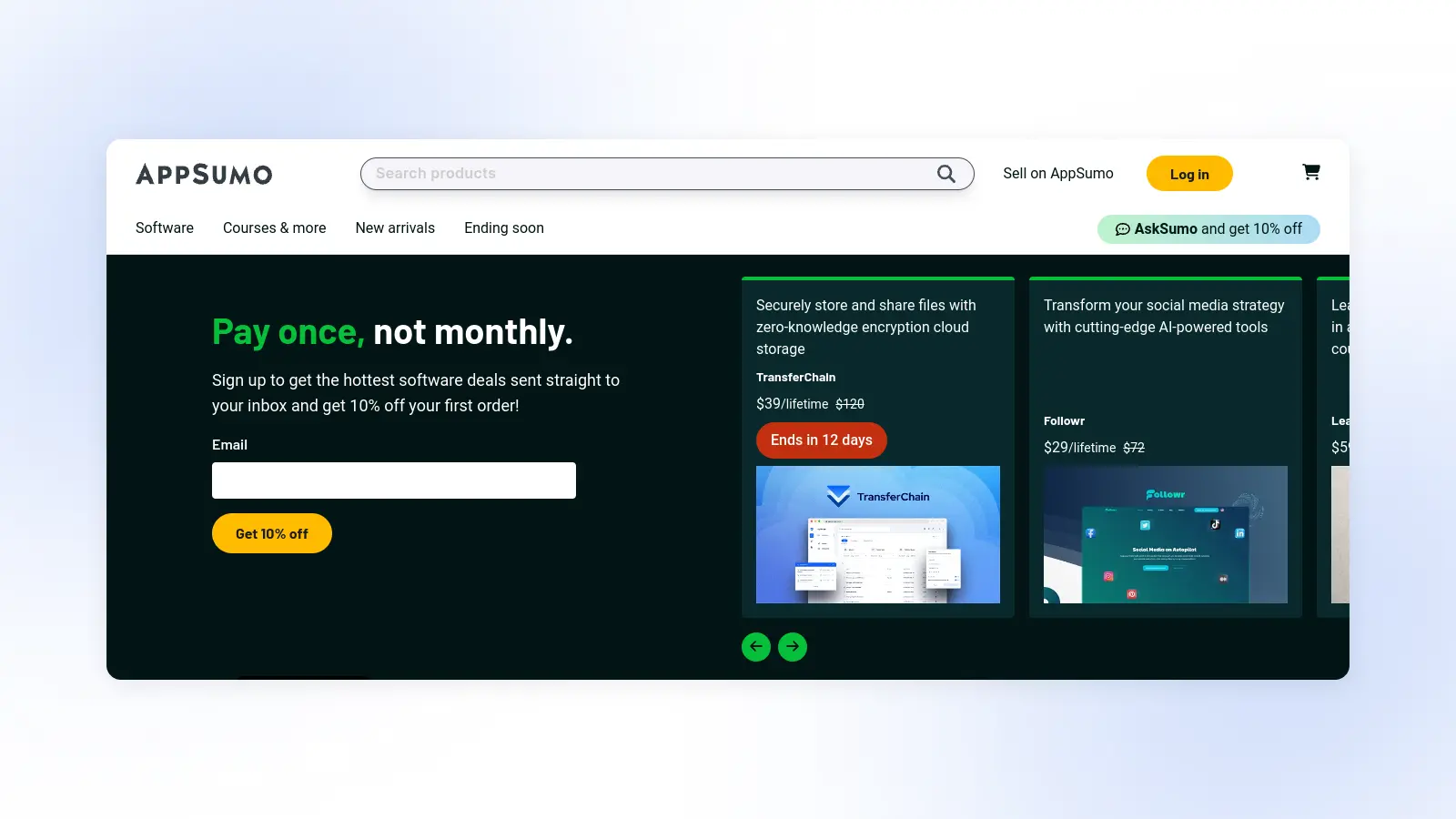
A SaaS Marketplace is an online platform that lists SaaS products available in the market. It connects SaaS companies with potential customers looking for their solutions.
Like any marketplace, they allow you to categorize your products and sell to targeted users.
They assist in marketing your products and provide a space for community discussions and reviews that act as social proof.
Some of the platforms include, AppSumo, and RocketHub.
Benefits: Listing on a reputable SaaS marketplace increases your credibility. It gives a faster reach to your target customers, building your audience from scratch.
You can lessen your marketing costs as these platforms carry out all the necessary campaigns including content production, lead generation, and sales.
Challenges: Your offerings will be placed against leading competitors. However, this can also enable you to highlight your unique selling points.
Conclusion
Most of the channels mentioned here are cost-effective and suitable for growing businesses to use. But not all may suit your business.
You can settle for multiple channels or select the right channels according to business needs, marketing goals, audience needs, and what may help you in the long term.
Additionally, keep track of these trends.


